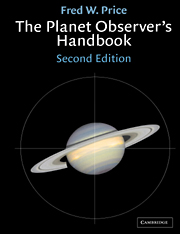Book contents
- Frontmatter
- Contents
- Foreword
- Preface
- Acknowledgements
- Abbreviations used in this book
- Introduction: Why observe the planets?
- 1 The Solar System
- 2 The celestial sphere
- 3 Telescopes and accessories
- 4 The atmosphere and seeing
- 5 Mercury
- 6 Venus
- 7 Mars
- 8 The minor planets (asteroids)
- 9 Jupiter
- 10 Saturn
- 11 Uranus
- 12 Neptune
- 13 Pluto
- 14 Constructing maps and planispheres
- 15 Planetary photography and videography
- 16 Photoelectric photometry of the minor planets, planets and their satellites
- Appendix: Milestones in Solar System exploration
- Name index
- Subject index
16 - Photoelectric photometry of the minor planets, planets and their satellites
Published online by Cambridge University Press: 05 August 2012
- Frontmatter
- Contents
- Foreword
- Preface
- Acknowledgements
- Abbreviations used in this book
- Introduction: Why observe the planets?
- 1 The Solar System
- 2 The celestial sphere
- 3 Telescopes and accessories
- 4 The atmosphere and seeing
- 5 Mercury
- 6 Venus
- 7 Mars
- 8 The minor planets (asteroids)
- 9 Jupiter
- 10 Saturn
- 11 Uranus
- 12 Neptune
- 13 Pluto
- 14 Constructing maps and planispheres
- 15 Planetary photography and videography
- 16 Photoelectric photometry of the minor planets, planets and their satellites
- Appendix: Milestones in Solar System exploration
- Name index
- Subject index
Summary
General
The development of photoelectric light measuring instruments (photometers) which have electronic light detectors and current amplifiers has made it possible for the weak current generated by the light of planets, their satellites and the asteroids focused by the telescope objective on the detector to be amplified sufficiently to cause deflection of a galvanometer needle or to give a digital readout as in more recent equipment.
Photoelectric photometry dates from about the latter part of the nineteenth century. The first ever photoelectric measurement of a star's light was made in 1892 with a 24-inch telescope belonging to an amateur. The observation was made by a professional astronomer, C. M. Minchin and two amateurs. Subsequent to this first amateur venture into photoelectric photometry, professional astronomers took it over completely during the next 60 years and it became widely available to them during the 1930s. Photoelectric measuring instruments are now available at prices affordable by most amateurs who are thus enabled to contribute much valuable data in this area of research.
Although astronomical photometry is done by professional astronomers using large telescopes, there are several advantages in amateur pursuit of this type of investigation:
There are more amateurs than professionals available to do this kind of work.
Amateurs don't have to ‘book’ time on large observatory telescopes which are available for short periods only. There is greater freedom and flexibility from owning their own telescopes.
Amateurs are able to spend more time on prolonged studies of selected objects.
- Type
- Chapter
- Information
- The Planet Observer's Handbook , pp. 405 - 414Publisher: Cambridge University PressPrint publication year: 2000



